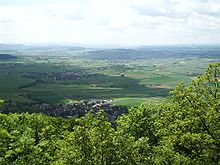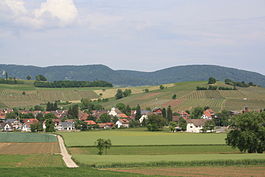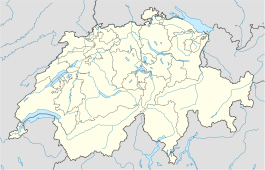- Oberhallau
-
Oberhallau Country Switzerland 
Canton Schaffhausen District n.a. 47°42′N 8°28′E / 47.7°N 8.467°ECoordinates: 47°42′N 8°28′E / 47.7°N 8.467°E Population 427 (Dec 2009)[1] - Density 71 /km2 (183 /sq mi) Area 6.04 km2 (2.33 sq mi) Elevation 430 m (1,411 ft) Postal code 8216 SFOS number 2972 Surrounded by Gächlingen, Hallau, Neunkirch, Schleitheim, Stühlingen (DE-BW) Website www.oberhallau.ch
Profile (German), SFSO statisticsView map of Oberhallau Oberhallau is a municipality in the canton of Schaffhausen in Switzerland.
Contents
History
Both Hallau and Oberhallau are first mentioned in 1095 as Hallaugia superiori et inferiori. Until the Peasants' War of 1653 it was part of Hallau.[2]
Coat of arms
The blazon of the municipal coat of arms is Azure a Fleur-de-lis Argent and overall a Key Or in fess.[3]
Geography
 View from the Siblinger watchtower west over the Klettgau. In the foreground is Siblingen, then Gächlingen and Hallau/Oberhallau.
View from the Siblinger watchtower west over the Klettgau. In the foreground is Siblingen, then Gächlingen and Hallau/Oberhallau.
Oberhallau has an area, as of 2006[update], of 6 km2 (2.3 sq mi). Of this area, 72.5% is used for agricultural purposes, while 20.5% is forested. Of the rest of the land, 6.8% is settled (buildings or roads) and the remainder (0.2%) is non-productive (rivers or lakes).[4] The municipality is located in the Unterklettgau district on the foot of the Hallauerberg.
Demographics
Oberhallau has a population (as of 2008[update]) of 425, of which 2.4% are foreign nationals. Of the foreign population, (as of 2008[update]), 30% are from Germany, 10% are from Italy, and 60% are from another country.[5] Over the last 10 years the population has decreased at a rate of 0%. Most of the population (as of 2000[update]) speaks German (97.2%), with Serbo-Croatian being second most common ( 1.0%) and English being third ( 0.5%).[4] The age distribution of the population (as of 2008[update]) is children and teenagers (0–19 years old) make up 22.4% of the population, while adults (20–64 years old) make up 61.6% and seniors (over 64 years old) make up 16%.[5]
In the 2007 federal election the most popular party was the SVP which received 61.5% of the vote. The next two most popular parties were the SP (23.7%), and the FDP (14.7%) .[4]
In Oberhallau about 84.3% of the population (between age 25-64) have completed either non-mandatory upper secondary education or additional higher education (either university or a Fachhochschule).[4] In Oberhallau, as of 2007[update], 3.56% of the population attend kindergarten or another pre-school, 4.28% attend a Primary School, 4.75% attend a lower level Secondary School, and 3.8% attend a higher level Secondary School.[5]
As of 2000[update], 13.6% of the population belonged to the Roman Catholic Church and 77.1% belonged to the Swiss Reformed Church.[5]
The historical population is given in the following table:[2]
year population 1771 399 1798 531 1836 762 1850 734 1900 534 1950 426 2000 397 Economy
Oberhallau has an unemployment rate, as of 2007[update], of 0.64%. As of 2005[update], there were 88 people employed in the primary economic sector and about 31 businesses involved in this sector. 18 people are employed in the secondary sector and there are 3 businesses in this sector. 25 people are employed in the tertiary sector, with 7 businesses in this sector.[4]
As of 2008[update] the mid year average unemployment rate was 0.4%. There were 14 non-agrarian businesses in the municipality and 47.8% of the (non-agrarian) population was involved in the secondary sector of the economy while 52.2% were involved in the third. At the same time, 54.3% of the working population was employed full-time, and 45.7% was employed part-time. There were 46 residents of the municipality who were employed in some capacity, of which females made up 58.7% of the workforce. As of 2000[update] there were 83 residents who worked in the municipality, while 128 residents worked outside Oberhallau and 18 people commuted into the municipality for work.[5]
As of 2008[update], there is 1 restaurant in the village and the hospitality industry in Oberhallau employs 2 people.[5]
Heritage sites of national significance
The Stone Age gravesite at Überhürst is listed as a Swiss heritage site of national significance.[6]
References
- ^ Swiss Federal Statistical Office, MS Excel document – Bilanz der ständigen Wohnbevölkerung nach Kantonen, Bezirken und Gemeinden (German) accessed 25 August 2010
- ^ a b Oberhallau in German, French and Italian in the online Historical Dictionary of Switzerland.
- ^ Flags of the World.com accessed 17-December-2009
- ^ a b c d e Swiss Federal Statistical Office accessed 17-December-2009
- ^ a b c d e f Statistical Office of the Canton of Schaffhausen (German) accessed 2 December 2009
- ^ Swiss inventory of cultural property of national and regional significance 21.11.2008 version, (German) accessed 17-Dec-2009
Bargen | Beggingen | Beringen | Buch | Buchberg | Büttenhardt | Dörflingen | Gächlingen | Guntmadingen | Hallau | Hemishofen | Hofen | Lohn | Löhningen | Merishausen | Neuhausen am Rheinfall | Neunkirch | Oberhallau | Ramsen | Rüdlingen | Schaffhausen | Schleitheim | Siblingen | Stein am Rhein | Stetten | Thayngen | Trasadingen | Wilchingen
Canton of Schaffhausen | Municipalities of the canton of Schaffhausen
 Categories:
Categories:- Municipalities of Schaffhausen
- Municipalities of Switzerland
- Cultural property of national significance in the canton of Schaffhausen
Wikimedia Foundation. 2010.


